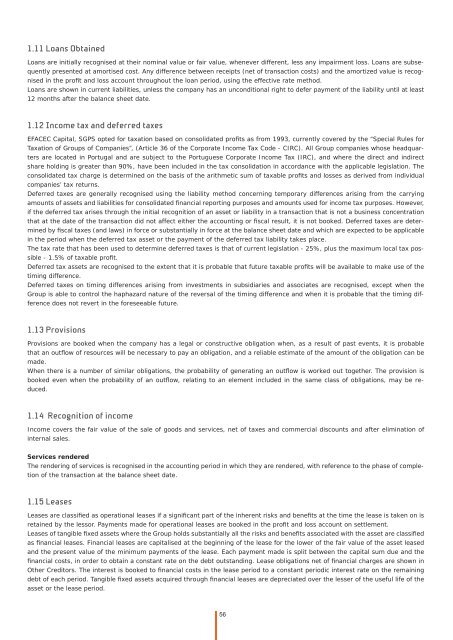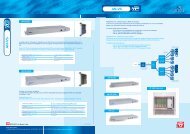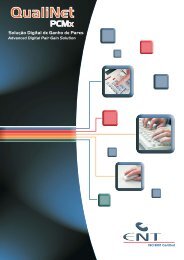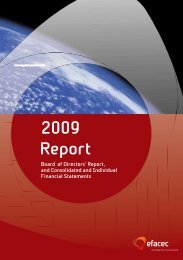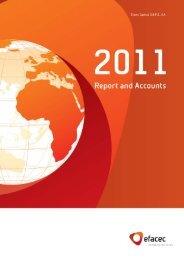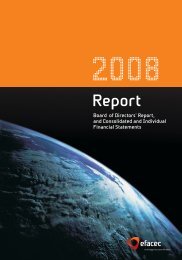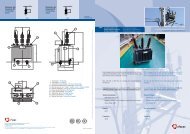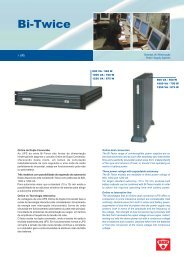Notes to the consolidated financial statements - Efacec
Notes to the consolidated financial statements - Efacec
Notes to the consolidated financial statements - Efacec
You also want an ePaper? Increase the reach of your titles
YUMPU automatically turns print PDFs into web optimized ePapers that Google loves.
1.11 Loans Obtained<br />
Loans are initially recognised at <strong>the</strong>ir nominal value or fair value, whenever different, less any impairment loss. Loans are subsequently<br />
presented at amortised cost. Any difference between receipts (net of transaction costs) and <strong>the</strong> amortized value is recognised<br />
in <strong>the</strong> profi t and loss account throughout <strong>the</strong> loan period, using <strong>the</strong> effective rate method.<br />
Loans are shown in current liabilities, unless <strong>the</strong> company has an unconditional right <strong>to</strong> defer payment of <strong>the</strong> liability until at least<br />
12 months after <strong>the</strong> balance sheet date.<br />
1.12 Income tax and deferred taxes<br />
EFACEC Capital, SGPS opted for taxation based on <strong>consolidated</strong> profi ts as from 1993, currently covered by <strong>the</strong> “Special Rules for<br />
Taxation of Groups of Companies”, (Article 36 of <strong>the</strong> Corporate Income Tax Code - CIRC). All Group companies whose headquarters<br />
are located in Portugal and are subject <strong>to</strong> <strong>the</strong> Portuguese Corporate Income Tax (IRC), and where <strong>the</strong> direct and indirect<br />
share holding is greater than 90%, have been included in <strong>the</strong> tax consolidation in accordance with <strong>the</strong> applicable legislation. The<br />
<strong>consolidated</strong> tax charge is determined on <strong>the</strong> basis of <strong>the</strong> arithmetic sum of taxable profi ts and losses as derived from individual<br />
companies’ tax returns.<br />
Deferred taxes are generally recognised using <strong>the</strong> liability method concerning temporary differences arising from <strong>the</strong> carrying<br />
amounts of assets and liabilities for <strong>consolidated</strong> fi nancial reporting purposes and amounts used for income tax purposes. However,<br />
if <strong>the</strong> deferred tax arises through <strong>the</strong> initial recognition of an asset or liability in a transaction that is not a business concentration<br />
that at <strong>the</strong> date of <strong>the</strong> transaction did not affect ei<strong>the</strong>r <strong>the</strong> accounting or fi scal result, it is not booked. Deferred taxes are determined<br />
by fi scal taxes (and laws) in force or substantially in force at <strong>the</strong> balance sheet date and which are expected <strong>to</strong> be applicable<br />
in <strong>the</strong> period when <strong>the</strong> deferred tax asset or <strong>the</strong> payment of <strong>the</strong> deferred tax liability takes place.<br />
The tax rate that has been used <strong>to</strong> determine deferred taxes is that of current legislation - 25%, plus <strong>the</strong> maximum local tax possible<br />
- 1.5% of taxable profi t.<br />
Deferred tax assets are recognised <strong>to</strong> <strong>the</strong> extent that it is probable that future taxable profi ts will be available <strong>to</strong> make use of <strong>the</strong><br />
timing difference.<br />
Deferred taxes on timing differences arising from investments in subsidiaries and associates are recognised, except when <strong>the</strong><br />
Group is able <strong>to</strong> control <strong>the</strong> haphazard nature of <strong>the</strong> reversal of <strong>the</strong> timing difference and when it is probable that <strong>the</strong> timing difference<br />
does not revert in <strong>the</strong> foreseeable future.<br />
1.13 Provisions<br />
Provisions are booked when <strong>the</strong> company has a legal or constructive obligation when, as a result of past events, it is probable<br />
that an outfl ow of resources will be necessary <strong>to</strong> pay an obligation, and a reliable estimate of <strong>the</strong> amount of <strong>the</strong> obligation can be<br />
made.<br />
When <strong>the</strong>re is a number of similar obligations, <strong>the</strong> probability of generating an outfl ow is worked out <strong>to</strong>ge<strong>the</strong>r. The provision is<br />
booked even when <strong>the</strong> probability of an outfl ow, relating <strong>to</strong> an element included in <strong>the</strong> same class of obligations, may be reduced.<br />
1.14 Recognition of income<br />
Income covers <strong>the</strong> fair value of <strong>the</strong> sale of goods and services, net of taxes and commercial discounts and after elimination of<br />
internal sales.<br />
Services rendered<br />
The rendering of services is recognised in <strong>the</strong> accounting period in which <strong>the</strong>y are rendered, with reference <strong>to</strong> <strong>the</strong> phase of completion<br />
of <strong>the</strong> transaction at <strong>the</strong> balance sheet date.<br />
1.15 Leases<br />
Leases are classifi ed as operational leases if a signifi cant part of <strong>the</strong> inherent risks and benefi ts at <strong>the</strong> time <strong>the</strong> lease is taken on is<br />
retained by <strong>the</strong> lessor. Payments made for operational leases are booked in <strong>the</strong> profi t and loss account on settlement.<br />
Leases of tangible fi xed assets where <strong>the</strong> Group holds substantially all <strong>the</strong> risks and benefi ts associated with <strong>the</strong> asset are classifi ed<br />
as fi nancial leases. Financial leases are capitalised at <strong>the</strong> beginning of <strong>the</strong> lease for <strong>the</strong> lower of <strong>the</strong> fair value of <strong>the</strong> asset leased<br />
and <strong>the</strong> present value of <strong>the</strong> minimum payments of <strong>the</strong> lease. Each payment made is split between <strong>the</strong> capital sum due and <strong>the</strong><br />
fi nancial costs, in order <strong>to</strong> obtain a constant rate on <strong>the</strong> debt outstanding. Lease obligations net of fi nancial charges are shown in<br />
O<strong>the</strong>r Credi<strong>to</strong>rs. The interest is booked <strong>to</strong> fi nancial costs in <strong>the</strong> lease period <strong>to</strong> a constant periodic interest rate on <strong>the</strong> remaining<br />
debt of each period. Tangible fi xed assets acquired through fi nancial leases are depreciated over <strong>the</strong> lesser of <strong>the</strong> useful life of <strong>the</strong><br />
asset or <strong>the</strong> lease period.<br />
56


